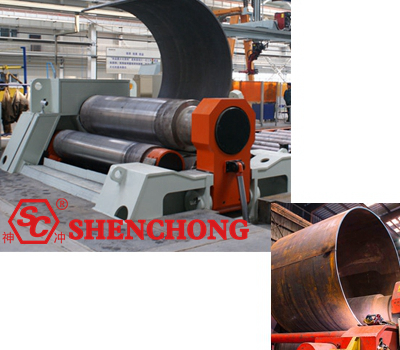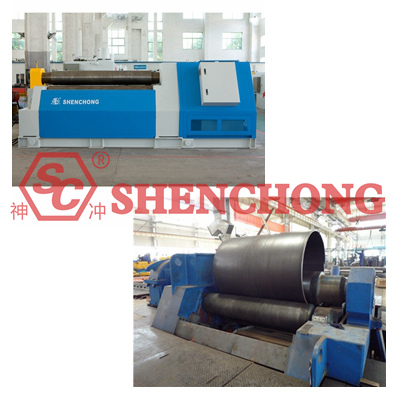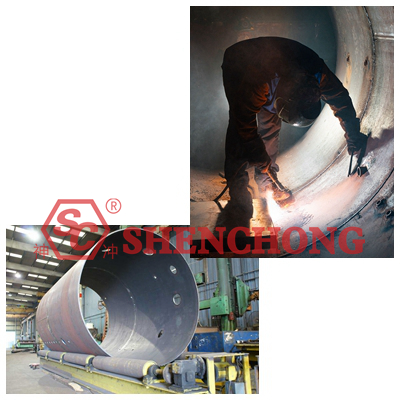

Boiler is an energy conversion equipment. The energy input to the boiler has chemical energy and electrical energy in the fuel. The output of the boiler has a certain thermal energy steam, high -temperature water or organic heat carrier.
According to the cutting code automatically generated by the nesting software, it is transmitted to each CNC fine plasma cutting machine equipment, which automatically recognizes and implements 1:1 cutting of the sheet metal.
Process the cut or milled shell and furnace liner materials into circular work pieces using a CNC rolling machine.

Like the edge milling process, both process the straight edge and groove shape of the work piece. The processing equipment mainly uses vertical lathes, so the work piece is mainly for edge pulling tube plates.
Fix the tube plate on a dedicated platform and use a radial drilling machine to expand and chamfer the cut bottom hole.
Assemble the boiler drum, furnace liner, and tube plate according to the two components of the boiler shell assembly and inner liner assembly, and weld all the components arranged inside the boiler drum (such as uniform steam orifice plate, diagonal pull rod) and the components that require double-sided welding (such as pipe seat, manhole ring, hand hole ring, etc.) in sequence.
After the longitudinal and circumferential seams of the main pressure parts (cylinder, tube plate) are assembled and qualified, a submerged arc welding machine is used to weld according to the corresponding welding process card requirements.
"Pipe" refers to seamless pipe, defined as smoke pipe or water pipe according to its purpose in boilers. Plate "refers to a flat steel plate, which corresponds to components such as the front tube plate, rear tube plate, and front and rear tube plates of the combustion chamber on the boiler. After the two are paired, an angle joint is formed, and then a specialized tube plate welding machine is used to achieve mechanical welding under argon protection.
Case Review: Tube production: tandem press brake bending and welding
The welding of furnace body mainly includes the assembly welding of components such as the smoke pipe of the combustion chamber, straight pull rod and tube plate, diagonal pull rod and tube plate, tube seat and pot shell, furnace body and base, etc., which can meet the conditions for hydraulic testing. The welding methods involved include electrode arc welding and mixed gas shielded welding.
Automatic Production Line: Sheet Metal Rolling And Welding Flexible Line
The strength and sealing testing of the boiler after assembly is carried out through the pressure of water.
Weld repair requirements:
For defects that are not allowed to exist on the weld seam, the cause should be identified and a feasible repair plan should be developed before the repair can be carried out.
The repaired weld seam should transition smoothly to the base metal after grinding and have the same overall dimensions as the original weld seam.
The welding materials used for repair welding should have the same welding requirements as the original product.
For repair at the junction of the drum ring and longitudinal seam, the longitudinal seam should be welded first, and then the circumferential seam.
Before repairing, defects should be thoroughly removed and it is prohibited to repair in contact with water.
When repairing pressure components of boilers that have undergone heat treatment, in principle, post welding heat treatment should be carried out in accordance with the original heat treatment specifications.
After welding seam repair, visual inspection and non-destructive testing should be carried out according to the quality requirements of the original welding seam. The repair at the same location shall not exceed two times.
After passing the appearance inspection of the repaired weld, the water pressure test shall be conducted again.

This process includes the production and installation of the front and rear smoke boxes of the boiler. The installation mainly involves assembling and welding the pre made smoke box components with the main body components, and laying and curing the insulation layer on their connecting parts. After all are completed, air tightness tests should be conducted.
This process includes the production and installation of boiler platform escalators. The installation mainly involves assembling and welding the pre made platform and body components, and then assembling the escalator components with the platform and body components, including the pre assembly of guardrails.
This process includes insulation layer, wrapping of external panels, installation of each pipe orifice gland, secondary installation of the platform, installation of electrical circuits, repainting of exposed parts, installation of product nameplates, and wrapping of dustproof cloth.
This process includes the installation of various pipeline valves, burner debugging and operation according to operating conditions, data measurement and analysis, and calculation of operating data.
The furnaces, pot pins, burners, water -cooled walls, overheats, coal vessels, air heater, architecture, and furnace walls in the boiler constitute the core part of the production steam. The two main components in the boiler body are furnaces and pots.
The furnace is also known as the burning room, which is a space for fuel. Put the solid fuel on the stove and the furnace of the fire bed is called a layer of burning furnace, also known as the fire machine. The burning furnace, also known as the fire room furnace. the air holds the coal kernels to burn it in a boiling state, and it is suitable for the furnace of the burning inferior fuel to be a boiling furnace, also known as the fluidized bed furnace. The cylinder -shaped furnace of the strong fire is called a whirlwind furnace. Auxiliary equipment and safety devices include safety valves, pressure gauges, water level tables, water level alarms, easy melting plugs, etc.
The design of the furnace needs to fully consider the characteristics of the use of fuel. Each boiler should use the fuel designed as much as possible. The economy and reliability of boilers running when fuels with large differences in fuel can be reduced.
It is a cylindrical container in natural circulation and multiple forced circulation boilers that receives water from the economizer, connects the circulation circuit, and delivers saturated steam to the superheater. The drum shell is made of high-quality thick steel plates and is one of the most important components in boilers.
The main function of the drum is to store water, perform steam water separation, remove salt water and sludge from the boiler water during operation, and prevent the boiler water containing high concentrations of salt and impurities from entering the superheater and turbine with the steam.
Including steam water separation and steam cleaning devices, water supply piping, sewage and dosing equipment, etc. The function of the steam water separation device is to separate the saturated steam and water from the water-cooled wall, and to minimize the small water droplets carried by the steam as much as possible. Middle and low pressure boilers commonly use baffles and gap baffles as coarse separation components. Boilers above medium pressure not only widely use various types of cyclone separators for coarse separation, but also use louvers, steel wire mesh, or equalizing plates for further separation. The drum is also equipped with monitoring and protection facilities such as a water level gauge and safety valve.
In order to assess performance and improve design, boilers often undergo heat balance tests. The method of directly calculating boiler thermal efficiency from the effective utilization of energy is called positive balance, and the method of calculating efficiency from various heat losses is called reverse balance.
When considering the actual benefits of a boiler room, it is not only necessary to consider the thermal efficiency of the boiler, but also to consider the energy consumed by the auxiliary equipment of the boiler. When a unit mass or unit volume of fuel is completely burned, the air demand calculated based on chemical reactions is called the theoretical air demand.
In order to provide more opportunities for fuel to come into contact with oxygen and burn in the furnace, the actual amount of air sent into the furnace must always be greater than the theoretical amount of air.
Although adding more air can reduce incomplete combustion heat loss, exhaust heat loss will increase, and it will also exacerbate sulfur oxide corrosion and nitrogen oxide generation. Therefore, efforts should be made to improve combustion technology and strive to achieve complete combustion in the furnace with a minimum excess air coefficient.
The dust (including fly ash and carbon black), sulfur, and nitrogen oxides contained in boiler flue gas are substances that pollute the atmosphere. When not purified, their emission indicators can reach several to tens of times the environmental protection regulations. The measures to control the emissions of these substances include pre combustion treatment, improvement of combustion technology, dust removal, desulfurization, and denitrification. The use of high chimneys can only reduce the concentration of pollutants in the atmosphere near the chimneys.
The forces used for flue gas dust removal include gravity, centrifugal force, inertial force, adhesion, sound wave, static electricity, etc. For coarse particles, gravity sedimentation and inertial force are generally used for separation, and centrifugal force is often used for dust removal at higher capacities. Electrostatic precipitators and bag filters have high dust removal efficiency. In wet and Venturi water film dust collectors, water droplets and water films can adhere to fly ash, with high dust removal efficiency and the ability to absorb gaseous pollutants.
The future development of boilers will further improve the thermal efficiency of boilers and power plants. Reduce the equipment cost per unit power of boilers and power stations. Improve the operational flexibility and automation level of boiler units. Developing more types of boilers to adapt to different fuels. Improve the operational reliability of boiler units and their auxiliary equipment. Reduce pollution to the environment.
The hot water or steam generated in boilers can directly provide the required heat energy for industrial production and people's lives, and can also be converted into mechanical energy through steam power devices, or mechanical energy can be converted into electrical energy through generators.
Boilers that provide hot water are called hot water boilers and are mainly used for daily life, but there are also a few applications in industrial production. The boiler that produces steam is called steam boiler, often referred to as boiler for short, and is mostly used in fossil-fuel power station, ships, locomotives, and industrial and mining enterprises.
- According to the flow of flue gas in boilers, they can be classified into: water tube boilers (i.e. the flow of water, steam, or a mixture of steam and water inside the building), shell boilers (heating surfaces where flue gas flows and releases heat inside the pipes and water absorbs heat outside the pipes), and water fire combination boilers.
- According to the fuel used in boilers, they can be divided into: coal-fired boilers (this type of boiler appeared relatively early and mainly used coal as fuel). Gas boilers (under the promotion of environmental protection by the state, gas boilers mainly focus on environmental protection). Oil fired boilers (mainly using light oil, heavy oil, and other oils as fuel). Biomass boilers (mainly fueled by crop waste such as peanut shells, corn cobs, corn stalks, etc.). Electric heating boilers (mainly powered by electricity).
- According to the purpose of boilers, they can be roughly divided into: domestic boilers (daily household water and heating). Industrial boilers (mostly used in places such as textile factories, food factories, clothing factories, etc. to provide steam to aid production). Power plant boilers (used for power generation in power plants).
- According to the working pressure of the boiler, it can be divided into: atmospheric pressure boiler (a type of boiler without any working pressure, which is quite safe and has no explosive danger). Pressure boiler (a type of boiler that operates under pressure and poses an explosive hazard.)
- According to the medium of the boiler, it can be divided into: steam boiler (boiler is mainly used for generating steam). Hot water boilers (mainly used for the production of hot water). Steam water dual purpose boiler (capable of simultaneously satisfying the use of steam without delaying the production of hot water). Organic heat carrier boiler (also known as thermal oil boiler, a special industrial furnace that can meet low pressure and provide high temperature heat energy).
- According to the steam pressure inside the boiler, it can be divided into: low-pressure boilers (boilers with an outlet steam pressure not exceeding 2.5MPa). Medium pressure boiler (boiler with outlet steam pressure between 2.94 and 4.90 MPa). Sub high pressure boiler (boiler with outlet steam pressure between medium pressure boiler and high pressure boiler). High pressure boiler (boiler with outlet steam pressure higher than 5.88MPa and lower than 9.81PMa). In addition, there are ultra-high pressure boiler, pressure critical pressure boiler and over pressure critical boiler.
- According to the number of boilers, it can be divided into: single drum boiler (fast installed boiler with working pressure of 1.3MPa and evaporation of 4t/h). Double drum boiler (boiler with working pressure of 1.3MPa and evaporation of 2t/h or 4t/h).
- According to the appearance of the boiler, it can be divided into: vertical boiler (this type of boiler has a relatively small capacity and floor space, so it is also relatively flexible). Horizontal boiler (this type of boiler has a relatively large capacity and appearance, and also occupies a large space).
- According to the classification of boiler levels, it can be divided into A level, B level, C level, D level, and E level (the classification of levels is based on the pressure of the boiler).